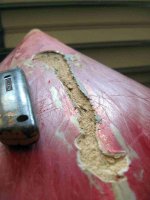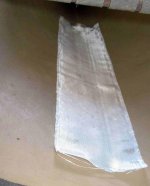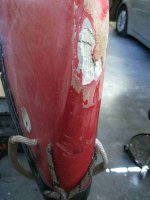Shortly after saying to my friends, "Sure I can patch the hole in your canoe" came............ "Oh do you mind replacing a cracked skid plate while you have the boat?"
And of course I agreed. But I did sense that any kevlar skid plate that was cracking was quite likely to have underlying problems. Well here they are:

It is the stern of this tandem that was getting worn down. It appears to have been patched once, then kevlar laid on top. I picked away the old patching material until I got to the foam core.
My plan is thickened epoxy and dynel to cover the area, perhaps 3 layers over the hull void.
Complimenting that patch would be a length of 6 inch fiberglass tape sufficient to span the exterior wear. The tape would be epoxied to the hull's interior and is intended to provide additional structural foundation at the point of wear. The internal vinyl showed some micro cracking, or perhaps just scratches, but most were centered directly above the external wear point. Reinforcement seems called for and the tape seemed a good choice of my on hand materials. I debated applying the fiberglass tape like two ribs, chose rather to run it straight down the keel which seems stronger(?)

STEM DAMAGE
I asked them to see if they couldn't remove the cracked skid plate to speed the repair process. Not sure if this damage was from the plate removal or if there were some problems before the plate was installed, But this is another problem that needs solving if this boat will float again.

STEM PICTURE FROM THE INSIDE

The stem problem vexes me. My first instinct is to fiberglass tape the inside before effecting an external repair. The internal patch will be an awkward affair.
Comments, thoughts, suggestions welcome.
And of course I agreed. But I did sense that any kevlar skid plate that was cracking was quite likely to have underlying problems. Well here they are:

It is the stern of this tandem that was getting worn down. It appears to have been patched once, then kevlar laid on top. I picked away the old patching material until I got to the foam core.
My plan is thickened epoxy and dynel to cover the area, perhaps 3 layers over the hull void.
Complimenting that patch would be a length of 6 inch fiberglass tape sufficient to span the exterior wear. The tape would be epoxied to the hull's interior and is intended to provide additional structural foundation at the point of wear. The internal vinyl showed some micro cracking, or perhaps just scratches, but most were centered directly above the external wear point. Reinforcement seems called for and the tape seemed a good choice of my on hand materials. I debated applying the fiberglass tape like two ribs, chose rather to run it straight down the keel which seems stronger(?)

STEM DAMAGE
I asked them to see if they couldn't remove the cracked skid plate to speed the repair process. Not sure if this damage was from the plate removal or if there were some problems before the plate was installed, But this is another problem that needs solving if this boat will float again.

STEM PICTURE FROM THE INSIDE

The stem problem vexes me. My first instinct is to fiberglass tape the inside before effecting an external repair. The internal patch will be an awkward affair.
Comments, thoughts, suggestions welcome.
